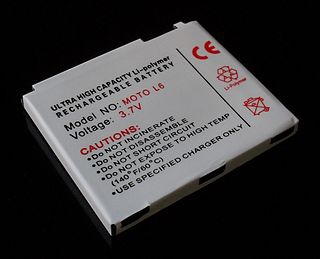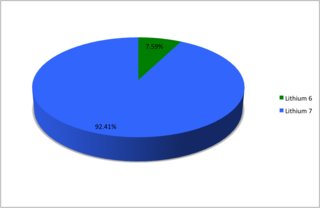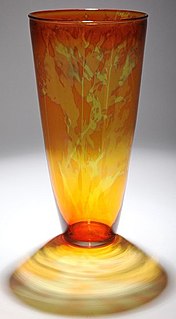
Lithium is a chemical element with the symbol Li and atomic number 3. It is a soft, silvery-white alkali metal. Under standard conditions, it is the lightest metal and the lightest solid element. Like all alkali metals, lithium is highly reactive and flammable, and must be stored in vacuum, inert atmosphere or inert liquid such as purified kerosene or mineral oil. When cut, it exhibits a metallic luster, but moist air corrodes it quickly to a dull silvery gray, then black tarnish. It never occurs freely in nature, but only in compounds, such as pegmatitic minerals, which were once the main source of lithium. Due to its solubility as an ion, it is present in ocean water and is commonly obtained from brines. Lithium metal is isolated electrolytically from a mixture of lithium chloride and potassium chloride.

Lithium carbonate is an inorganic compound, the lithium salt of carbonate with the formula Li
2CO
3. This white salt is widely used in the processing of metal oxides, and as a drug for the treatment of mood disorders.

In chemistry, a silicate is any member of a family of anions consisting of silicon and oxygen, usually with the general formula [SiO(4−2x)−
4−x]
n, where 0 ≤ x < 2. The family includes orthosilicate SiO4−
4, metasilicate SiO2−
3, and pyrosilicate Si
2O6−
7. The name is also used for any salt of such anions, such as sodium metasilicate; or any ester containing the corresponding chemical group, such as tetramethyl orthosilicate.

A lithium-ion battery or Li-ion battery is a type of rechargeable battery in which lithium ions move from the negative electrode through an electrolyte to the positive electrode during discharge, and back when charging. Li-ion batteries use an intercalated lithium compound as the material at the positive electrode and typically graphite at the negative electrode.

A lithium polymer battery, or more correctly lithium-ion polymer battery, is a rechargeable battery of lithium-ion technology using a polymer electrolyte instead of a liquid electrolyte. High conductivity semisolid (gel) polymers form this electrolyte. These batteries provide higher specific energy than other lithium battery types and are used in applications where weight is a critical feature, such as mobile devices, radio-controlled aircraft and some electric vehicles.

Organolithium reagents are organometallic compounds that contain carbon – lithium bonds. These reagents are important in organic synthesis, and are frequently used to transfer the organic group or the lithium atom to the substrates in synthetic steps, through nucleophilic addition or simple deprotonation. Organolithium reagents are used in industry as an initiator for anionic polymerization, which leads to the production of various elastomers. They have also been applied in asymmetric synthesis in the pharmaceutical industry. Due to the large difference in electronegativity between the carbon atom and the lithium atom, the C-Li bond is highly ionic. Owing to the polar nature of the C-Li bond, organolithium reagents are good nucleophiles and strong bases. For laboratory organic synthesis, many organolithium reagents are commercially available in solution form. These reagents are highly reactive, and are sometimes pyrophoric.

Lithium hydroxide is an inorganic compound with the formula LiOH.(H2O)n. Both the anhydrous and hydrated forms are white hygroscopic solids. They are soluble in water and slightly soluble in ethanol. Both are available commercially. While classified as a strong base, lithium hydroxide is the weakest known alkali metal hydroxide.

Lithium chloride is a chemical compound with the formula LiCl. The salt is a typical ionic compound (with certain covalent characters), although the small size of the Li+ ion gives rise to properties not seen for other alkali metal chlorides, such as extraordinary solubility in polar solvents (83.05 g/100 mL of water at 20 °C) and its hygroscopic properties.

Lithium batteries are primary batteries that have metallic lithium as an anode. These types of batteries are also referred to as lithium-metal batteries.

Naturally occurring lithium (3Li) is composed of two stable isotopes, lithium-6 and lithium-7, with the latter being far more abundant on Earth. Both of the natural isotopes have an unexpectedly low nuclear binding energy per nucleon when compared with the adjacent lighter and heavier elements, helium and beryllium. The longest-lived radioisotope of lithium is lithium-8, which has a half-life of just 838.7±0.3 milliseconds. Lithium-9 has a half-life of 178.2±0.4 ms, and lithium-11 has a half-life of 8.75±0.06 ms. All of the remaining isotopes of lithium have half-lives that are shorter than 10 nanoseconds. The shortest-lived known isotope of lithium is lithium-4, which decays by proton emission with a half-life of about 91±9 yoctoseconds, although the half-life of lithium-3 is yet to be determined, and is likely to be much shorter, like helium-2 (diproton) which undergoes proton emission within 10−9 s.

Lithium bromide (LiBr) is a chemical compound of lithium and bromine. Its extreme hygroscopic character makes LiBr useful as a desiccant in certain air conditioning systems.
Metasilicates are silicates containing ions of empirical formula SiO2−
3. Common stoichiometries include MI
2SiO3 and MIISiO3.

Sodium metasilicate is the chemical substance with formula Na
2SiO
3, which is the main component of commercial sodium silicate solutions. It is an ionic compound consisting of sodium cations Na+
and the polymeric metasilicate anions [–SiO2−
3–]n. It is a colorless crystalline hygroscopic and deliquescent solid, soluble in water but not in alcohols.

Lithium sulfate is a white inorganic salt with the formula Li2SO4. It is the lithium salt of sulfuric acid.

Lithium oxide (Li
2O) or lithia is an inorganic chemical compound. It is a white solid. Although not specifically important, many materials are assessed on the basis of their Li2O content. For example, the Li2O content of the principal lithium mineral spodumene (LiAlSi2O6) is 8.03%.
The lithium iron phosphate battery or LFP battery, is a type of lithium-ion battery using lithium iron phosphate as the cathode material, and a graphitic carbon electrode with a metallic backing as the anode. The energy density of LiFePO
4 is lower than that of lithium cobalt oxide, and also has a lower operating voltage. The charge-discharge profiles of LFP cells are typically very flat. The main drawback of LiFePO
4 is its low electrical conductivity. Therefore, all the LiFePO
4 cathodes under consideration are actually LiFePO
4/C. Because of low cost, low toxicity, well-defined performance, long-term stability, etc. LiFePO
4 is finding a number of roles in vehicle use, utility scale stationary applications, and backup power. LFP batteries are cobalt-free.
Lithium burning is a nucleosynthetic process in which lithium is depleted in a star. Lithium is generally present in brown dwarfs and not in low-mass stars. Stars, which by definition must achieve the high temperature (2.5 × 106 K) necessary for fusing hydrogen, rapidly deplete their lithium.

Photosensitive glass, also known as photostructurable glass (PSG), or photomachinable glass, is a crystal-clear glass that belongs to the lithium-silicate family of glasses, in which an image of a mask can be captured by microscopic metallic particles in the glass when it is exposed to short wave radiations such as ultraviolet light. Photosensitive glass was first discovered by S. Donald Stookey in 1937.

Lithium compounds, also known as lithium salts, are primarily used as a psychiatric medication. They are primarily used to treat bipolar disorder and treat major depressive disorder that does not improve following the use of antidepressants. In these disorders, it reduces the risk of suicide. Lithium is taken orally.

In 2020, Lithium has been included in the list for Critical global elements critical metal, and will be one of the drivers of the fourth industrial revolution. Lithium company stocks on the worldwide exchanges have rallied from the end of 2020 and through 2021 with many Lithium Explorers/Developers/Producer miners' share prices' rising 1000% to 6000% within 12 months on the ASX: the Australian Securities Stock Exchange. Stocks are expected to continue to rally as a shortfall deficit of Lithium supply world-wide is expected from beginning of 2022. The Battery-grade Lithium deficit is expected to persist to an incredible 2030, as there are not enough mines coming online to supply the demand in EV Batteries & Energy Storage systems to 2030. This makes Lithium a highly lucrative commodity to invest into, the term entered a "Lithium commodities Super-cycle" has been used by industry commentators during 2021 to describe the event, also the term "A Once in a Century" event is occurring in 2021 and will persist till new Energy technologies come online to replace Lithium Batteries, this is not expected till after 2040 as there are no technologies that will be suitable for the diversity of applications for Lithium Energy storage systems. Lithium carbonate prices have made a resurgence from 2019-2020 all time lows, rising some 500% as of 21/11/2021 trading at US$29,000/tonne, Lithium Carbonate/Lithium Hydroxide is a Lithium chemical compound also known as LCE(Lithium Carbonate Equivalent) and is used as a Precursor in the manufacture of Cathode Cells for electric vehicle (EV) batteries. As a result and along with major Governmental new energy policies in 2020, in preparation to the fazing out of fossil fuels & reductions in carbon emissions vehicles & coal power, has kick-started a flurry of renewed investments & Joint Ventures/acquisitions between Miners & Strategic major investor companies throughout the world. Recently the world saw the COP26: Climate Change Summit for Action in Glasgow during November 2021. The agreements signed by all countries involved, has accelerated the action towards renewables adoption & the reforestation among other items & actions. Lithium will play a key & critical role towards the reduction of Carbon emissions, "1.5ToStayAlive" "1.5toSurvive" slogans for maintaining the critical 1.5 degrees & the storage of renewables clean green energy, harnessed from the sustainable wind, solar & hydropower, also tidal. Also big on the COP26 agenda was the fazing out of coal all-together.














